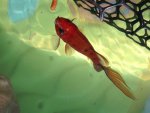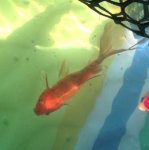Mmathis
TurtleMommy
- Joined
- Apr 28, 2011
- Messages
- 13,918
- Reaction score
- 8,099
- Location
- NW Louisiana -- zone 8b
- Hardiness Zone
- 8b
- Country

This topic has been posted before, but thought I would broach the subject again.
___________________________________
THIS PART IS JUST MY RAMBLING THOUGHTS, NOT WHAT MY TOPIC IS ABOUT -- READ TOWARD THE END FOR MY TOPIC:
From a survival-in-nature view point, it's obvious why fish (well, most animals) will start out their lives with a dull or camo-type coloration or patterning. And of course, even our fancier pond-raised breeds will still start out dull, as it's in their genetics.
There is a lot of interest (and information) in the way koi change colors, and it's FASCINATING! Koi are beautiful, and their color patterns are more striking than what's seen in goldfish.
But WHY do both koi and goldfish/Shubunkins change sometimes change SO MUCH during their lifetimes (assuming it's not due to an issue related to environmental quality)???
END OF RAMBLING THOUGHTS
_________________________________
MY TOPIC: What is the usual PROGRESSION of colors & patterning [mainly] with Shubunkins and goldies? What colors & patterns are stable and which ones are more likely to change over time?
I have a fairly new Shubie that I'm keeping an eye on. What attracted me to him, was that he (and another tank mate) looked almost NEON ORANGE. Now that I'm paying more attention to the color, it seems that he has an overlay of orange over black that's making this "neon" effect. Cool! Now wishing I'd also purchased the other fish!
___________________________________
THIS PART IS JUST MY RAMBLING THOUGHTS, NOT WHAT MY TOPIC IS ABOUT -- READ TOWARD THE END FOR MY TOPIC:
From a survival-in-nature view point, it's obvious why fish (well, most animals) will start out their lives with a dull or camo-type coloration or patterning. And of course, even our fancier pond-raised breeds will still start out dull, as it's in their genetics.
There is a lot of interest (and information) in the way koi change colors, and it's FASCINATING! Koi are beautiful, and their color patterns are more striking than what's seen in goldfish.
But WHY do both koi and goldfish/Shubunkins change sometimes change SO MUCH during their lifetimes (assuming it's not due to an issue related to environmental quality)???
END OF RAMBLING THOUGHTS
_________________________________
MY TOPIC: What is the usual PROGRESSION of colors & patterning [mainly] with Shubunkins and goldies? What colors & patterns are stable and which ones are more likely to change over time?
I have a fairly new Shubie that I'm keeping an eye on. What attracted me to him, was that he (and another tank mate) looked almost NEON ORANGE. Now that I'm paying more attention to the color, it seems that he has an overlay of orange over black that's making this "neon" effect. Cool! Now wishing I'd also purchased the other fish!



